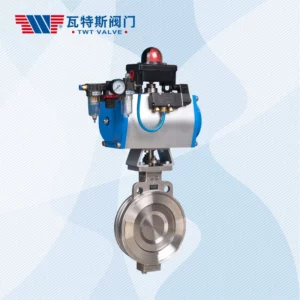Electric pneumatic butterfly valves play a crucial role in process automation and control in industrial settings due to their ability to provide precise control, quick response, and reliable operation.
Here’s how these valves contribute to automation and control:
- Actuation Flexibility:
- Electric pneumatic butterfly valves combine the advantages of both electric and pneumatic actuation. Electric actuators provide precise and efficient control, while pneumatic actuators offer quick and reliable operation.
- This combination allows for versatile control options, making it suitable for various industrial processes that require different levels of control and automation.
- Remote Control and Monitoring:
- Electric actuators can be easily integrated into control systems, allowing for remote control and monitoring. Operators can make adjustments and receive real-time information about valve position and performance, enhancing the automation capabilities of the system.
- Proportional Control:
- Electric actuators enable proportional control, meaning the valve position can be finely adjusted to control the flow rate or process parameters. This is crucial in applications that require precise regulation, such as chemical manufacturing or water treatment.
- Modulating Control:
- Electric pneumatic butterfly valves can be used for modulating control, where the valve’s position changes continuously to maintain a set process variable. This ensures consistent and accurate control of various industrial processes.
- On-Off Control:
- These valves are also capable of on-off control, providing the ability to completely open or close the valve in response to specific process conditions or alarms.
- Safety and Reliability:
- Pneumatic actuators offer fail-safe operation, as they can return the valve to a safe position (open or closed) in case of power loss or other failures, contributing to the safety of industrial processes.
- Quick Response:
- Pneumatic actuators provide rapid valve response, making them suitable for applications where immediate adjustments are required, such as in emergency shutdowns.
- Energy Efficiency:
- Electric actuators are known for their energy-efficient operation. They consume power only when actuating the valve, reducing energy costs in the long run.
- Diagnostics and Condition Monitoring:
- Electric actuators often come with built-in diagnostics and condition monitoring capabilities, allowing for predictive maintenance and ensuring the continued reliability of the valve.
- Process Optimization:
- Electric pneumatic butterfly valves support the optimization of industrial processes by providing the means to maintain specific parameters, ensuring product quality and system efficiency.
In summary, electric pneumatic butterfly valves enhance process automation and control in industrial settings by offering a combination of precise control, quick response, remote monitoring, and fail-safe operation. They are used in various industries, including chemical, oil and gas, water treatment, and more, where automation and precise control are critical for efficient and safe operations.
What types of fluids or gases can these valves handle, and what considerations are important when selecting them for specific applications?
Electric pneumatic butterfly valves can be used to control a wide range of fluids and gases in industrial applications. However, the suitability of these valves for specific fluids or gases depends on several factors, including the materials of construction, temperature, pressure, and the nature of the medium being handled.
Here are some considerations and examples of the types of fluids or gases they can handle:
1. Liquids:
- Water: Electric pneumatic butterfly valves are commonly used in water treatment and distribution systems.
- Wastewater: They can handle various wastewater types, including sewage and industrial effluents.
- Chemicals: These valves can be used with various chemicals, provided that the materials of construction are compatible with the specific chemicals being handled.
- Oils and fuels: They are suitable for applications involving the control of oils and various hydrocarbon-based fuels.
2. Gases:
- Natural Gas: Electric pneumatic butterfly valves can control the flow of natural gas in distribution and industrial systems.
- Compressed Air: They are used in compressed air systems for various industrial applications.
- Process Gases: These valves can handle process gases used in manufacturing and industrial processes.
3. Steam:
- Electric pneumatic butterfly valves can be used in applications where steam control is required, such as in power generation or industrial steam systems.
4. High-Temperature Fluids:
- Some models of electric pneumatic butterfly valves are designed to handle high-temperature fluids and can be used in applications with elevated temperature requirements.
When selecting electric pneumatic butterfly valves for specific applications, the following considerations are important:
- Material Compatibility: Ensure that the materials of construction are compatible with the fluid or gas being controlled. Different materials are used for different media, and compatibility is crucial to prevent corrosion or deterioration.
- Temperature Range: Consider the temperature range of the application. electric pneumatic butterfly valves Some valves are rated for high-temperature service, while others may not be suitable for extreme temperatures.
- Pressure Rating: Check the pressure rating of the valve to ensure it can handle the operating pressure of the system.
- Flow Characteristics: Determine the flow characteristics of the medium to choose the appropriate valve type (e.g., control, on-off) and actuation method.
- Corrosion Resistance: In corrosive environments, select valves with corrosion-resistant materials to ensure a long service life.
- Regulatory Compliance: Ensure that the valves meet any relevant industry standards or regulations specific to your application.
- Safety and Reliability: Consider the fail-safe features of the valve, especially in critical applications where safety and reliability are paramount.
In summary, electric pneumatic butterfly valves can handle a variety of fluids and gases, but it’s essential to consider material compatibility, temperature, pressure, and other specific application requirements when selecting the appropriate valve for a given system.
